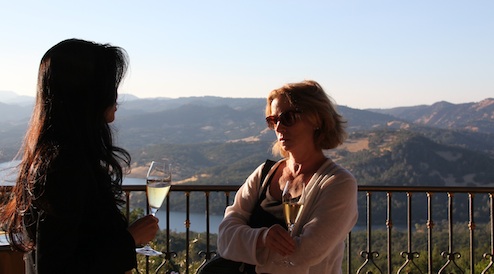
The beauty of the Mayacamas mountain ranges with manicured vineyards being cooled by the Pacific Ocean breeze took my breath away when I first visited Napa Valley in 1990. Part of wine industry’s allure for me has always been about much more than the seductive wines but also the lifestyle, the people and the beautiful wine growing regions. There are so many scenic wine regions in the world: the rugged Cape Town landscape with the dramatic horizons in South Africa ranks among the most beautiful; the undulating valleys of Tuscany with its quaint villages are picturesque; the charming towns at the foot of the steep slopes of the Mosel Valley are gorgeous. But Napa is special because it combines visually stunning landscapes with people who are extremely friendly, passionate about wine and have built up a great wine tourism industry. Tastings rooms are large and inviting and one is often greeted by a bubbly Californian tasting room attendant who smiles as though you have just made their day by walking in through the tasting room door. As you depart, you will often hear, “Great to have you visit us! I hope you enjoy your visit to Napa Valley!” Napa ranks as one of the most sophisticated and friendly wine tourism destinations in the world. Spend a day visiting any wine region in France or Italy and you will know what I mean. However, on my recent trip to Napa, I could not help but notice that the smiles were not as wide and the happy optimism in people’s voices seemed a tad tired and forced. As I spoke to people within the wine industry, on both the East and West coasts over several weeks, it was clear that the US wine industry is suffering from an economic downturn hangover. The cure for the hangover? The growing Asian wine market. In the past few decades while the French have spent huge air miles promoting their wines in Hong Kong, the Americans were homebound busy catering to their own growing domestic demand for fine wines. With the economic downturn however, Americans are trading down and corporate expense accounts to which extravagant meals were charged have dried up. Suddenly Asia looks like the promise land where bottles that cost US$500-750 per bottle may be snatched up as quickly as Hermes crocodile handbags. Bill Harlan is one of the pioneers in Asia, having established strong distribution channels for his cult wine Harlan Estates. A savvy businessman, Harlan believes Asia is the future. He says, “I am committed to being in Asia long term. Over the next 25 years, it will be the most important wine market. We may be fighting against the tide now but when it turns, we want to be there. By being there, we will have the best chance for being accepted and for being a leader.” The importance of the Asian market is a sentiment that was repeated again and again when I visited top wine producers in Napa such as Opus One, Colgin, Harlan and Araujo. Michael Silacci, head winemaker of Opus One says that nearly all of the top management’s overseas travels are now to Asia. Some like Bart Araujo have made their first trip to Hong Kong only this year and are committed to returning often. For small producers like Harlan or Colgin, selling wines made in such minute quantities shouldn’t be a problem in Asia. With production of less than 2,000 cases per year, these boutique properties produce a fraction of their Bordeaux first growth counterparts. We are in a great position based in Hong Kong, we have the wine world knocking on our door – I know I will be looking forward to more frequent winemaker dinners with the top Californian producers.
Reprinted with permission from the South China Morning Post









